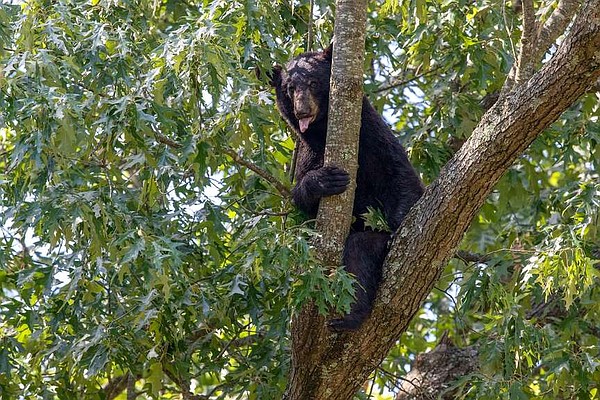On June 10, a bear was spotted near Rock Creek, reminding everyone that Arkansas is home to one of the most successful reintroductions of a large carnivore in history. As a state rich in nature, Arkansas’ bear population is undoubtedly a source of pride for many wildlife lovers here in Arkansas, but it also means that every May and June, male bears venture too close to town in search of new habitat.
Unfortunately, young bears have a hard time telling the difference between a blackberry bush and a corn feeder or trash can when searching for a calorie-dense snack.
“We get a lot of calls about bears getting too close to towns and cities during the summer months, and the majority of these are young male bears,” said Myron Means, large carnivore program coordinator for the Arkansas Game and Fish Commission. “These bears have overwintered twice with their mothers and are now looking for new homes.”
After yearlings emerge from their dens in the spring, they follow two different paths in life, depending on their sex, Means said. Female yearlings stay close to their mothers and can establish territories next to their mothers’ territories, but males are chased out and forced to find new homes.
“This prevents inbreeding and helps the species expand,” Means said. “Some of the young males may be encountering humans for the first time.”
According to BearWise.org, a website maintained by bear biologists and the Fish and Wildlife Association, these young bears are a lot like teenagers setting out on their own for the first time: Most bears quickly learn to avoid human locations, but if they find trash cans and wildlife feeders to be ideal prey, they’re likely to establish a home and claim the backyard as their own.
“Ninety percent of bear nuisance calls can be dealt with by simply removing any food the bear finds,” Means said. “The first thing I say to landowners when we get calls is: If you remove any easily accessible food, the bear will usually leave quickly.”
Corn feeders and trash cans that are prone to tipping over are obvious targets for inquisitive bears, but other food sources like bird feeders and barbecue grills with dirty trays that haven’t been cleaned also attract pesky bears. A complete checklist to help landowners in Arkansas bear habitat prepare for these possibilities is available at BearWise.org.
Only a small number of female bears pose a nuisance complaint, but they are often looking for food to maintain weight while caring for their cubs. Their early-summer food, leaves and grasses, are not as calorific as the berries and acorns that soon become abundant in much of the state. During this time of year, females may show up for a free meal if food is left out.
“Bears are opportunistic, but they won’t become aggressive unless you make them feel comfortable,” Means said. “If you overlook something and a bear starts wandering around, remove the food and make sure it understands it doesn’t belong in your backyard. If you do that when it first shows up, it usually doesn’t take long to scare it away. Most of the times we’ve had to trap and remove a bear, it’s because we let the bear stay long enough that it enjoyed being nearby and thought that’s where it belonged. That always creates problems down the line – not just for the landowner who let the bear in, but for neighbors and other landowners who have to deal with a bear that’s no longer afraid of humans.”
Not only is it a bad idea, but it is also illegal to purposely scatter or feed bears to lure them into certain areas. The only exception is 30 days before the start of bear hunting season until the end of the season. It is also illegal to place certain wildlife feeders on your property if you live in an area where there is a risk of chronic wasting disease, which is found in deer and elk.
More information: www.BearWise.org.
Randy Zellers is deputy chief of public affairs for the Arkansas Game and Fish Commission.


